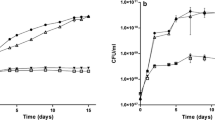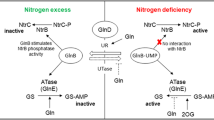Abstract
At least five highly conserved, but disparately regulated groESL operons are present in Bradyrhizobium japonicum. Expression of groESL 3 is coregulated with symbiotic nitrogen fixation genes, implying a role of GroESL chaperonins in the nitrogen fixation process. Null mutants of individual groEL genes, however, were not impaired in symbiotic nitrogen fixation activity. By contrast, the groEL 3-plus-groEL 4 double mutant strain D4, which is mutated in those groEL genes that contribute most to the GroEL pool under symbiotic conditions, exhibited less than 5% Fix activity as compared to the wild-type. Expression of lacZ fusions made to several representative nif and fix genes was not, or only marginally, reduced in mutant D4, indicating that the requirement of chaperonins for nitrogen fixation does not occur at the level of RegSR-NifA-σ54- or FixLJ-FixK2-dependent gene regulation. Instead, immunoblot analyses revealed that the level of NifH and NifDK nitrogenase proteins was drastically decreased in extracts prepared from D4 bacteroids and from free-living cells grown anaerobically. Transcriptional fusions of the anaerobically induced groESL 3 promoter (P3) to all five B. japonicum groESL operons and also to groESL from Escherichia coli were integrated into the chromosome of mutant D4. Strains harboring P3 fused to groESL 1, groESL 2, groESL 5, or E. coli groESL partially complemented the symbiotic defect of mutant D4, whereas the wild-type phenotype was completely restored in strains complemented with P3 fused to groESL 3 (control) or groESL 4. Likewise, the growth defect of an E. coli groEL mutant could be corrected at least partially by individual B. japonicum groESL operons. In conclusion, both series of complementation analyses were not indicative of a strict substrate specificity of any of the B. japonicum groESL gene products, which is in good agreement with their high degree of sequence conservation.
Similar content being viewed by others
Author information
Authors and Affiliations
Additional information
Received: 4 November 1998 / Accepted: 7 January 1999
Rights and permissions
About this article
Cite this article
Fischer, HM., Schneider, K., Babst, M. et al. GroEL chaperonins are required for the formation of a functional nitrogenase in Bradyrhizobium japonicum. Arch Microbiol 171, 279–289 (1999). https://doi.org/10.1007/s002030050711
Issue Date:
DOI: https://doi.org/10.1007/s002030050711




